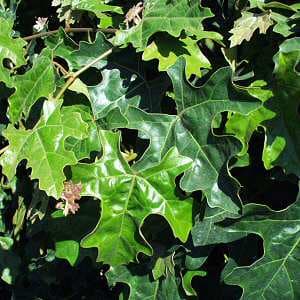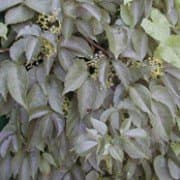Grape Ivy Cissus rhombifolia

ABOUT
The plant known commonly as grape ivy or oakleaf ivy is a lush, climbing vine with tendrils that allow it to grasp onto supports and structures. The foliage of this plant is its most distinctive feature, showcasing glossy, deep green leaves that are often shaped like a diamond or a rhombus, with pointed tips. These leaves frequently exhibit a textured surface with visible veins that give them a slightly puckered appearance. Grape ivy can be an attractive addition to indoor spaces due to this ornamental foliage, which can provide a touch of greenery as it cascades or climbs in its environment. The plant tends to grow vigorously under favorable conditions, with the leaves forming a dense coverage that can be visually striking.
About this plant
 Names
NamesSynonyms
Grape Ivy, Oakleaf Ivy, Venezuela Treebine, Water Vine, Rex Begonia Vine
Common names
Cissus rhombifolia.variifolia, Cissus rhombifolia var. canescens, Vitis rhombifolia, Vitis variifolia.
 Toxicity
ToxicityTo humans
Grape Ivy is not considered toxic to humans. However, like many plants, it may cause mild irritation or an allergic reaction if the sap comes into contact with the skin or if parts of the plant are ingested. There are no severe symptoms of poisoning known for humans from ingesting Grape Ivy, but it's generally recommended to avoid eating any part of ornamental plants.
To pets
Grape Ivy is also not considered toxic to pets. It does not contain any known toxic compounds that would pose a risk to cats, dogs, or other household pets. However, ingestion of plant matter can sometimes lead to gastrointestinal upset in animals, so while Grape Ivy is not recognized for severe toxicity, pets that eat the plant might experience symptoms such as vomiting or diarrhea due to irritation of the stomach or intestines. It's always best to keep houseplants out of reach of pets to avoid any potential issues.
 Characteristics
CharacteristicsLife cycle
Perennials
Foliage type
Evergreen
Color of leaves
Green
Height
10 feet (3.05 meters)
Spread
6 feet (1.83 meters)
Plant type
Climber
Hardiness zones
10
Native area
Tropical Africa
Benefits
 General Benefits
General Benefits- Easy to care for: Cissus rhombifolia, commonly known as grape ivy, is a low-maintenance plant that can thrive with minimal care, making it suitable for busy individuals or novice gardeners.
- Aesthetic appeal: With its lush, green foliage and graceful vining habit, grape ivy can add a touch of nature's beauty to any indoor setting.
- Versatile in use: Grape ivy is adaptable and can be used in a variety of ways such as hanging baskets, climbing on trellises, or simply as a potted indoor plant.
- Growth adaptability: Grape ivy can adapt to a range of light conditions, though it prefers bright, indirect light, it can still grow in lower light conditions.
- Enhances humidity: Grape ivy can help maintain a more desirable humidity level in dry indoor environments, contributing to a more comfortable living space.
 Medical Properties
Medical PropertiesThis plant is not used for medical purposes.
 Air-purifying Qualities
Air-purifying QualitiesThis plant is not specifically known for air purifying qualities.
 Other Uses
Other Uses- Cissus rhombifolia, commonly known as grape ivy, can be used in terrariums for its ability to thrive in humid environments and provide dense foliage for aesthetic purposes.
- In creative landscaping, grape ivy can be shaped and trained on various structures like arbors or trellises to create living sculptures and intricate garden designs.
- Grape ivy can be utilized as a natural screen or privacy barrier on balconies and patios, where its climbing nature can cover unattractive fences or walls.
- Suitable for hanging baskets, grape ivy adds a cascade of greenery when hung from ceilings or perches in indoor and outdoor spaces.
- Its robust growth habit makes grape ivy a good companion plant, as it can provide shade and support to less vigorous or more delicate plants.
- In eco-friendly fashion, grape ivy can be integrated into live plant jewelry, such as living necklaces or bracelets, where small cuttings are kept within wearable planters.
- As a part of biophilic design in architecture, grape ivy can contribute to the aesthetic integration of nature into modern buildings and workspaces.
- During festive seasons, grape ivy can serve as a natural decoration, being woven into wreaths or used as green accents in flower arrangements.
- Due to its hardiness, grape ivy can be employed in educational projects and biology classes to demonstrate plant growth and climbing mechanisms.
- As an activity for children, grape ivy cuttings can be used to teach the basics of plant propagation and care in simple home gardening projects.
Interesting Facts
 Feng Shui
Feng ShuiThe Grape Ivy is not used in Feng Shui practice.
 Zodiac Sign Compitability
Zodiac Sign CompitabilityThe Grape Ivy is not used in astrology practice.
 Plant Symbolism
Plant Symbolism- Resilience: The Grape Ivy, or Cissus rhombifolia, is a hardy vine that can adapt to various environments, symbolizing the ability to thrive in different conditions and bounce back from adversity.
- Growth: As a climbing vine, the Grape Ivy represents continuous growth and expanding one's horizons, both personally and professionally.
- Entanglement: Due to its nature of clinging and wrapping around structures, it can also symbolize situations or relationships that are complex or intertwined.
- Protection: In its natural habitat, the Grape Ivy can provide shelter for smaller plants and animals; symbolically, it can represent protection and shelter for individuals or ideas.
- Adaptability: Acknowledging the plant's versatility, it stands for the ability to adapt to and flourish in varying circumstances, much like the plant does in low or bright light conditions.
 Water
WaterThe Grape Ivy or Oakleaf Ivy should be watered when the top inch of the soil feels dry to the touch. Typically, this means watering once a week, but this can vary depending on the humidity and temperature of the environment. When watering, provide enough water so that it runs through the drainage holes, indicating that the soil is thoroughly moistened. It is best to water the plant with roughly 16 to 32 ounces of water, adjusting the amount based on the size of the pot and the plant's growth stage. During the winter months, reduce watering as the plant's growth slows down.
 Light
LightGrape Ivy thrives in bright, indirect light. It should be placed near a window that receives plenty of light, but protected from direct sunlight which can scorch its leaves. A north-facing or east-facing window is ideal for providing the correct lighting conditions. If the light is too low, the plant's growth may become leggy and sparse.
 Temperature
TemperatureGrape Ivy prefers a temperature range between 60°F and 80°F for optimal growth. It should not be exposed to temperatures below 50°F, as cold drafts and sudden temperature drops can damage the plant. The ideal temperature range to maintain is between 65°F and 75°F to keep the Grape Ivy healthy and thriving.
 Pruning
PruningPrune Grape Ivy to maintain its shape and encourage fuller growth. Pruning is best done in the spring or early summer when the plant is actively growing. Cut back any long, leggy stems or dead leaves to promote new growth. Trimming the plant every few months will keep it looking tidy and healthy.
 Cleaning
CleaningAs needed
 Soil
SoilFor a Grape Ivy, a well-draining soil mix composed of peat, perlite, and pine bark is ideal. The soil pH should be between 5.5 to 6.5 to ensure optimal growth.
 Repotting
RepottingGrape Ivy should ideally be repotted every 2-3 years to replenish the soil and give the roots more space to grow.
 Humidity & Misting
Humidity & MistingGrape Ivy thrives at humidity levels around 40-50%, which mimics their native tropical environment.
 Suitable locations
Suitable locationsIndoor
Provide bright, indirect light and room to climb for indoor Grape Ivy.
Outdoor
Place in partial shade and shelter Grape Ivy from harsh elements.
Hardiness zone
10-11 USDA
 Life cycle
Life cycleThe life of Cissus rhombifolia, commonly known as the grape ivy, starts with seed germination in warm, moist soil conditions. After germination, it enters the seedling stage where the first leaves and roots develop as it establishes itself. As it progresses to the vegetative stage, the plant experiences rapid growth, producing a vining stem and characteristic 'grape-like' foliage, expanding through runners and enabling it to spread or climb. When mature, grape ivy enters the flowering stage, though blooming is infrequent in cultivation, with small, non-showy flowers that may eventually give way to berry-like fruits if pollinated. These fruits contain seeds that can then be dispersed to start new plants, thus continuing its life cycle. As a perennial, Cissus rhombifolia can live for many years, with proper care, by continuously cycling through growth and dormancy phases in response to seasonal changes.
 Propogation
PropogationPropogation time
Spring to Summer
Propogation: The most popular method of propagation for the Grape Ivy, or Cissus rhombifolia, is through stem cuttings. This typically occurs during the spring or early summer when the plant's growth is most active. To propagate, a healthy stem cutting of about 4 to 6 inches (10 to 15 cm) long is selected with several leaves and at least one node. The lower leaves are removed, and the cut end can be dipped in rooting hormone powder to encourage root growth. The cutting is then inserted into a moist soil mixture. Providing a warm environment and maintaining soil moisture without making it soggy are crucial to encourage rooting. Within a few weeks, the cutting should develop roots and can be treated as a new plant.





![Grape [Claret Cloak]](/_next/image?url=https%3A%2F%2Fplants-admin.emdemapps.com%2Fimages%2Fplants%2F%2Fimages%2F604b602abe2f8.png&w=640&q=75)



